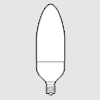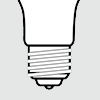Lighting Solutions
Information on this page will help you compare bulb features, brightness and efficiency, color choices, shape choices, and bulb base choices.
How Much Can You Save?
Use this savings calculator to see how much you can save each year by replacing standard incandescent bulbs with energy-efficient bulbs.
| Please enter a value for this field. | |
| Please enter a value for this field. | |
| Bulb Type | Cost/yr | Savings/yr compared to incandescent |
| Incandescent | ||
| Halogen | ||
| CFL | ||
| LED |
Here is how the most common types of bulbs compare:
Features

* Annual cost of operation based on 800 lumens for 2 hours per day at $0.22 per kWh. ** CFLs and LEDs require compatible dimmers.
Brightness and Efficiency
Because bulbs vary in their efficiency, it’s best to compare bulbs based on their light output (lumens) rather than their wattage (amount of energy used). The higher the number of lumens, the brighter the light will be. Higher wattage bulbs use more energy. Here’s how bulbs compare: 
Color Choices
Traditional incandescent bulbs emit a “warm” color. Today, bulbs are available in a range of colors:
| Warm White, Soft White The standard color of incandescent bulbs | Cool White, Neutral, Bright White Good for kitchens and work spaces | Neutral or Daylight Good for reading |
| 2700K3000K | 3500K4100K | 5000K6500K |
Shape Choices
 A-Line (e.g., A19, A21, or omni directional) bulbs disperse light at a wide angle and are ideal for fixtures used to spread light throughout the room. A-line bulbs are a good choice for room area-lighting, reading lamps, and hallways.
A-Line (e.g., A19, A21, or omni directional) bulbs disperse light at a wide angle and are ideal for fixtures used to spread light throughout the room. A-line bulbs are a good choice for room area-lighting, reading lamps, and hallways.
 Spotlights (e.g., R20, BR30, BR40, etc.) concentrate light in a small area to produce a bright spot of light. Spotlights are a good option for track lighting and overhead recessed lighting.
Spotlights (e.g., R20, BR30, BR40, etc.) concentrate light in a small area to produce a bright spot of light. Spotlights are a good option for track lighting and overhead recessed lighting.
 Floodlights (e.g., PAR20, PAR30, etc.) cast a wider directional light than spotlights. Floodlights are ideal for recessed lighting, outdoor lighting, landscape lighting, and motion sensors.
Floodlights (e.g., PAR20, PAR30, etc.) cast a wider directional light than spotlights. Floodlights are ideal for recessed lighting, outdoor lighting, landscape lighting, and motion sensors.
 Candelabra and Miniature Candelabra bulbs (e.g., E11, E12, etc.) imitate the shape of a candle and provide ambient and accent lighting. They are for use in decorative lighting fixtures, including wall sconces, decorative fixtures and chandeliers.
Candelabra and Miniature Candelabra bulbs (e.g., E11, E12, etc.) imitate the shape of a candle and provide ambient and accent lighting. They are for use in decorative lighting fixtures, including wall sconces, decorative fixtures and chandeliers.
Bulb Base Choices
 Medium (e.g., E26, E27) – The bulb base design for standard light bulbs used in most lamps and overhead light fixtures
Medium (e.g., E26, E27) – The bulb base design for standard light bulbs used in most lamps and overhead light fixtures
 Intermediate (e.g., E17) – A bulb base between the candelabra and medium sizes, commonly used in ceiling fans
Intermediate (e.g., E17) – A bulb base between the candelabra and medium sizes, commonly used in ceiling fans
 Candelabra (e.g., E12) – A slightly smaller bulb base, used in chandeliers, light sconces and other small fixtures
Candelabra (e.g., E12) – A slightly smaller bulb base, used in chandeliers, light sconces and other small fixtures
 Miniature Candelabra (e.g., E11) – An even smaller bulb base, frequently used in chandeliers
Miniature Candelabra (e.g., E11) – An even smaller bulb base, frequently used in chandeliers
 Pin (e.g., GU10, GU24) – These CFL and LED bulbs have twist-and-lock dual-pin connectors.
Pin (e.g., GU10, GU24) – These CFL and LED bulbs have twist-and-lock dual-pin connectors.
Other Resources:
- If you’re replacing a burnt out CFL bulb, click here to find a recycling location near you.
